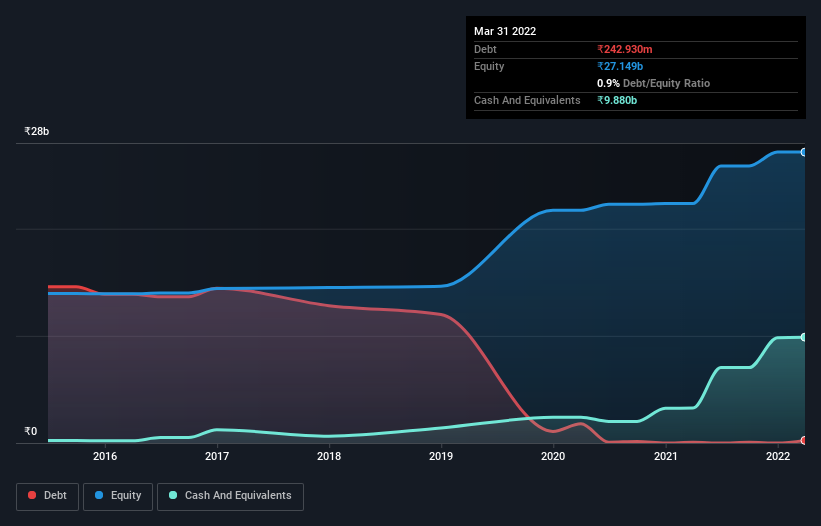Linde India (NSE:LINDEINDIA) Has A Rock Solid Balance Sheet

Legendary fund manager Li Lu (who Charlie Munger backed) once said, 'The biggest investment risk is not the volatility of prices, but whether you will suffer a permanent loss of capital.' When we think about how risky a company is, we always like to look at its use of debt, since debt overload can lead to ruin. As with many other companies Linde India Limited (NSE:LINDEINDIA) makes use of debt. But should shareholders be worried about its use of debt?
Why Does Debt Bring Risk?
Debt is a tool to help businesses grow, but if a business is incapable of paying off its lenders, then it exists at their mercy. Part and parcel of capitalism is the process of 'creative destruction' where failed businesses are mercilessly liquidated by their bankers. However, a more common (but still painful) scenario is that it has to raise new equity capital at a low price, thus permanently diluting shareholders. Having said that, the most common situation is where a company manages its debt reasonably well - and to its own advantage. The first thing to do when considering how much debt a business uses is to look at its cash and debt together.
Check out our latest analysis for Linde India
What Is Linde India's Net Debt?
You can click the graphic below for the historical numbers, but it shows that as of December 2021 Linde India had ₹242.9m of debt, an increase on ₹69.0m, over one year. However, it does have ₹9.88b in cash offsetting this, leading to net cash of ₹9.64b.

A Look At Linde India's Liabilities
Zooming in on the latest balance sheet data, we can see that Linde India had liabilities of ₹8.75b due within 12 months and liabilities of ₹4.26b due beyond that. On the other hand, it had cash of ₹9.88b and ₹6.58b worth of receivables due within a year. So it actually has ₹3.44b more liquid assets than total liabilities.
Having regard to Linde India's size, it seems that its liquid assets are well balanced with its total liabilities. So it's very unlikely that the ₹277.9b company is short on cash, but still worth keeping an eye on the balance sheet. Simply put, the fact that Linde India has more cash than debt is arguably a good indication that it can manage its debt safely.
On top of that, Linde India grew its EBIT by 50% over the last twelve months, and that growth will make it easier to handle its debt. When analysing debt levels, the balance sheet is the obvious place to start. But it is future earnings, more than anything, that will determine Linde India's ability to maintain a healthy balance sheet going forward. So if you want to see what the professionals think, you might find this free report on analyst profit forecasts to be interesting.
Finally, a company can only pay off debt with cold hard cash, not accounting profits. While Linde India has net cash on its balance sheet, it's still worth taking a look at its ability to convert earnings before interest and tax (EBIT) to free cash flow, to help us understand how quickly it is building (or eroding) that cash balance. Happily for any shareholders, Linde India actually produced more free cash flow than EBIT over the last three years. That sort of strong cash generation warms our hearts like a puppy in a bumblebee suit.
Summing up
While it is always sensible to investigate a company's debt, in this case Linde India has ₹9.64b in net cash and a decent-looking balance sheet. And it impressed us with free cash flow of ₹4.5b, being 126% of its EBIT. So we don't think Linde India's use of debt is risky. There's no doubt that we learn most about debt from the balance sheet. However, not all investment risk resides within the balance sheet - far from it. We've identified 1 warning sign with Linde India , and understanding them should be part of your investment process.
If, after all that, you're more interested in a fast growing company with a rock-solid balance sheet, then check out our list of net cash growth stocks without delay.
New: AI Stock Screener & Alerts
Our new AI Stock Screener scans the market every day to uncover opportunities.
• Dividend Powerhouses (3%+ Yield)
• Undervalued Small Caps with Insider Buying
• High growth Tech and AI Companies
Or build your own from over 50 metrics.
Have feedback on this article? Concerned about the content? Get in touch with us directly. Alternatively, email editorial-team (at) simplywallst.com.
This article by Simply Wall St is general in nature. We provide commentary based on historical data and analyst forecasts only using an unbiased methodology and our articles are not intended to be financial advice. It does not constitute a recommendation to buy or sell any stock, and does not take account of your objectives, or your financial situation. We aim to bring you long-term focused analysis driven by fundamental data. Note that our analysis may not factor in the latest price-sensitive company announcements or qualitative material. Simply Wall St has no position in any stocks mentioned.
About NSEI:LINDEINDIA
Flawless balance sheet with high growth potential.


